Protecting and restoring Ann Arbor's natural areas and fostering an environmental ethic among its citizens.
Volume 23, Number 1
Spring 2018
Park Focus: Furstenberg Nature Area
Alex Cherry, Outreach Assistant
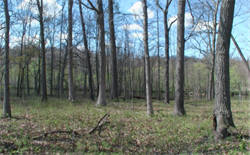 A springtime walk through Furstenberg Nature Area is an absolute feast for the senses. The air feels warm, seemingly for the first time in years after a long winter. Droplets of water fall through the oaks and hickories. It is not raining but the sensation of precipitation coupled with the rushing, high waters of the Huron River gives that feeling. It is migration season. A chorus of languages only understood by our feathered companions floods the canopy. Touching the brilliantly white petal of a dogwood puts a word to the feeling: rejuvenated.
A springtime walk through Furstenberg Nature Area is an absolute feast for the senses. The air feels warm, seemingly for the first time in years after a long winter. Droplets of water fall through the oaks and hickories. It is not raining but the sensation of precipitation coupled with the rushing, high waters of the Huron River gives that feeling. It is migration season. A chorus of languages only understood by our feathered companions floods the canopy. Touching the brilliantly white petal of a dogwood puts a word to the feeling: rejuvenated.
The springtime display of the riverfront’s flora and fauna was not always this beautiful. Recent dedication to this natural area has allowed it to flourish.
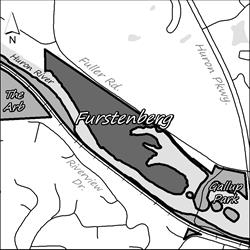 The land that is now Furstenberg Nature Area was acquired in 1971 by the City of Ann Arbor. It was not until the 1990s, however, that major ecological and aesthetic improvements began. The boardwalk and bridge connecting Gallup and Furstenberg gave greater access to the park. Fire management and invasive shrub removal improved the area’s ecological quality and biodiversity. Today, one can see the changes by strolling through or paddling by the marvelous 38 acres.
The land that is now Furstenberg Nature Area was acquired in 1971 by the City of Ann Arbor. It was not until the 1990s, however, that major ecological and aesthetic improvements began. The boardwalk and bridge connecting Gallup and Furstenberg gave greater access to the park. Fire management and invasive shrub removal improved the area’s ecological quality and biodiversity. Today, one can see the changes by strolling through or paddling by the marvelous 38 acres.
It is easy to appreciate the giant oaks while gazing through the woods and savanna of the park. What many miss are the small, but important treasures that lie closer to the forest floor. The inconspicuous sedge, mistaken commonly for grass, is an important plant native to the natural areas of Ann Arbor. 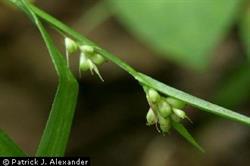 Look for species like the woodland sedge (Carex blanda) or Pennsylvania sedge (Carex pensylvanica) in the oak-hickory forest and savanna of Furstenberg. Two important identifying factors for these species are their triangular stems and small flowers that form "spikes". The sedges are an important food source for small mammals, birds and invertebrates living in the park.
Look for species like the woodland sedge (Carex blanda) or Pennsylvania sedge (Carex pensylvanica) in the oak-hickory forest and savanna of Furstenberg. Two important identifying factors for these species are their triangular stems and small flowers that form "spikes". The sedges are an important food source for small mammals, birds and invertebrates living in the park.
One of the most delightful activities to do within Furstenberg is to watch wildlife. The system of trails winding through the park hold benches and viewing points to catch a glimpse of some of the interesting species that establish themselves in the spring. The swaying cattails of Furstenberg’s marsh offer a chorus of animal vocalizations. Gray tree frogs, Green frogs and Wood frogs call to one another, especially in the evening hours. During the day, Red-winged blackbirds make their famous "konk-la-ree" song, an indicator of the spring. Along the Huron River, there are more observation opportunities. 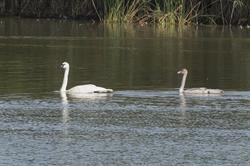 The rare Trumpeter swan will take a breather here while making its journey to the northern United States. Painted turtles, after a long winter snooze, will begin to sun themselves during the first balmy days at Furstenberg. Wildlife is abundant and exciting at this park.
The rare Trumpeter swan will take a breather here while making its journey to the northern United States. Painted turtles, after a long winter snooze, will begin to sun themselves during the first balmy days at Furstenberg. Wildlife is abundant and exciting at this park.
There is more to the value of a natural area than just its physical beauty. Nondescript plants and animals may have important characteristics that allow an ecosystem to thrive. Riverside vegetation can reduce run-off into the water and control erosion. What makes Furstenberg a special park is that it possesses all of these attributes. Natural beauty, important ecosystems, and a riparian buffer combine to make this nature area a valuable piece of land. With continued dedication to its restoration, Furstenberg will continue to grow as a prime destination for those seeking to enjoy time spent in the natural areas of Ann Arbor.
Join us on May 6 for workdays at Furstenberg. See the calendar for details.
Coordinators Corner: How Do You Turn a Nut into a Tree?
Dave Borneman, Natural Area Preservation Manager
In his 1977 book The Nature of Vegetation: Its Management and Mismanagement, Ecologist Frank Egler says, "Nature is not only more complex than we think, it’s more complex than we can think." That’s a humbling notion, and it outlines the daunting challenge for those of us tasked with managing our public natural areas.
Initially the task seems pretty straightforward: protect remnant natural areas from being destroyed by human activity. Put a fence around it, and make it a park. That’s the initial step. After that, it gets a bit more complicated. We control invasive species. We sow native plant seeds. We re-introduce fire. And those are all good steps to take. We’re making progress. But are we making enough progress? Are we reaching our goal of actually restoring and sustaining our native ecosystems? That’s a question I ask myself more and more these days, after a couple decades of trying to achieve this elusive goal.
What would success look like? Well, in many of our parks, I think that would include a healthy native oak woodland ecosystem, reminiscent of what existed here prior to European settlement, relatively free of invasive species. And to be "healthy," I’d want to see not only big, old oak trees, but young ones as well, oak seedlings and saplings in enough abundance that they could be expected to replace the canopy oaks that have been here, in many cases, since before Ann Arbor was even founded. I’d like us to be able to create and sustain an "arbor" of oaks like that which gave our city its name. But how do we do that?
The first step in creating new oak trees is getting acorns to germinate on the forest floor. That alone has been a challenge. Wander through most of our parks and you’ll see plenty of large oak trees, but look down and it’s hard to find any oak seedlings on the forest floor. Why is that? Well, in order to germinate, acorns need two things: contact with bare mineral soil, and plenty of sunlight. Those conditions don’t exist in many of our parks today, although we’re making progress. Removing invasive shrubs and re-introducing prescribed fire is a tremendous help in creating conditions conducive to germinating acorns. And those sites where we’ve done the most burning are the sites where we see the most young oaks germinating, such as in Furstenberg Nature Area, which you’ll read about in Alex’s article in this newsletter. Burning removes the leaf litter so acorns can reach the soil. And it helps more sunlight reach the forest floor. The result: we get oak seedlings!
Unfortunately, creating oak seedlings is only the first step; we still need to get those seedlings up through sapling stage. And that too is a big challenge. Lots of things feed on tender young oak seedlings, such as rabbits, mice, voles, and yes – deer. And the same prescribed burns that create conditions conducive to acorn germination can have a negative impact on the oak seedlings themselves, either killing them or severely setting them back.
How do we deal with these challenges? What’s our plan for getting those oak seedlings into the sapling stage so our grandchildren can look forward to the same oak arbor that our grandparents enjoyed? Those questions will be answered in the next newsletter…
A Morning in the Life of a Burn Boss
Tina Stephens, Volunteer and Outreach Coordinator
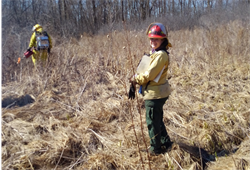 By now, most of you have heard about NAP’s controlled burn program. Perhaps you’ve seen the skeletons of invasive shrubs we’ve killed, read about the number of acres burned in our last edition, or maybe you’ve even joined our volunteer burn crew. It goes without saying that a lot of effort and planning goes into each and every burn we conduct to ensure the safety of crew and community as well as accomplish the ecological objectives. For a bit of fun, I thought I’d pull back the curtain a little bit and give you a glimpse into what a typical morning looks like for a NAP burn boss.
By now, most of you have heard about NAP’s controlled burn program. Perhaps you’ve seen the skeletons of invasive shrubs we’ve killed, read about the number of acres burned in our last edition, or maybe you’ve even joined our volunteer burn crew. It goes without saying that a lot of effort and planning goes into each and every burn we conduct to ensure the safety of crew and community as well as accomplish the ecological objectives. For a bit of fun, I thought I’d pull back the curtain a little bit and give you a glimpse into what a typical morning looks like for a NAP burn boss.
5:35 am Wake up and check the weather – high of 67°F, wind speed of 18 mph, wind direction SSE, relative humidity getting down to a low of 42% at 1:30 p.m. Sure looks like a burn day! Cross-reference the weather with the list of burn sites and acceptable wind directions. Text Dave, Becky, and Mike to discuss site options. After a bit of back and forth discussing upcoming workdays, which sites are highest priority, and where we have concerns about rare and endangered species, we settle on Marshall Nature Area.
5:43 am Roll out of bed and put on yesterday’s dirty burn gear. No point taking a shower on a burn day. Grab a quick breakfast.
6:28 am Arrive at the NAP office. Check the weather forecast. Still the same. Submit a spot weather forecast request to the National Weather Service. A spot forecast has more site specific fire-related details than a general regional forecast. Text the NAP ornithologist and herpetologist to make sure they’re okay with the plan. Make a few copies of the site map, grab flagging, marker, and some more flagging.
6:47 am Get to Marshall Nature Area just before sunrise. Take just a moment to enjoy the beauty and peace of a natural area at dawn – this is likely the only moment of silence for the rest of the day.
6:49 am Start flagging the unit. This flagging marked with letters will be used by the burn crew to orient during the burn. While flagging, I’m marking down all of the points on a map and beginning to plan exactly how I will conduct the burn. I also make notes of where hazards or fire-sensitive things are, such as hollow trees or benches.
8:04 am Make it back to the NAP office to copy the map of the flagged points and give the field crew directions for how to prep the site. Check the spot weather forecast, making sure the hyper-local forecast is similar to the expected conditions. Inform the Outreach team that it’s a burn day.
8:17am Have a quick second breakfast. All that flagging and mapping makes a girl hungry!
8:20 am Run the smoke modeling forecast and make a map of where "Prescribed Burn Ahead" road signs should be placed. 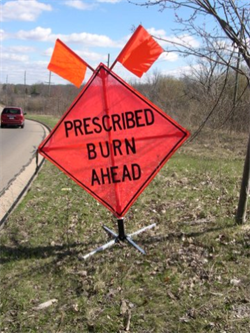
Check in with Dave for approval of the maps and my intended ignition pattern.
8:39 am Check in with the Outreach team to see how notifications are going. Return a call to a park neighbor who requests that we burn her favorite mushroom hunting spot.
8:58 am Time to triage emails! Since I’m only at my desk for a short time today, this is the only chance I’ll get to return emails and phone calls about everything that can’t wait until after burn season.
9:55 am Lunch time! I’ve got just 20 minutes to eat lunch, get on the rest of my burn gear, use a flush toilet for the last time today, finish up this one last email, and copy enough maps for all of the crew and volunteers. Eek!
10:15 am One last check to make sure I have everything I’ll need for the day and a final read of the prescription before I leave for the park.
10:45 am I get to Marshall Nature Area and check in with the field crew to see how prep is going and if they found any hazards that I missed during my early morning walk through. Then check in with the outreach team to make sure we are ready for the volunteers to arrive.
10:58 am Greet the volunteers as they arrive and help them get geared up. I also check in about any physical or time limitations.
11:14 am I find a quiet spot to make my final plans:
- who will be our smoke monitor
- which volunteers and staff should be paired up to spread out experience and continue to train everyone on each position
- which teams should be on interior ignition
- which team gets to light the head fire, etc.
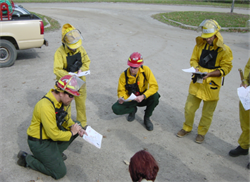 11:20 am Briefing time. This is the pre-burn meeting where I give all of the burn crew members their assignment for the day, talk though expected fire behavior, review the objective for the burn, and point out any potential hazards. I also do one last check on the weather forecast to make sure the wind, humidity, and sky cover are still as expected.
11:20 am Briefing time. This is the pre-burn meeting where I give all of the burn crew members their assignment for the day, talk though expected fire behavior, review the objective for the burn, and point out any potential hazards. I also do one last check on the weather forecast to make sure the wind, humidity, and sky cover are still as expected.
11:30 am Let’s do this! I give the fire department a quick call to let them know were ready to get started just as I light the test fire.
All of that and it’s not even noon! I hope you’ve enjoyed this little peek into my morning. If you’re interested in knowing what happens next, I invite you to join us on our next burn. Check a2gov.org, facebook.com/ann.arbor.NAP, or twitter.com/a2NAP for announcements about controlled burns.
NAPpenings
Thank you!
Many thanks to the groups who volunteered with NAP recently. We could not make such a difference without you!
Circle K, UM
Ecological Issues Class, UM
EMU VISION
Epsilon Eta, UM
Michigan Running Club, UM
Phi Chi Theta, UM
Sigma Chi, Kettering University
Sigma Chi-Theta Theta Chapter, UM
YVC, Ann Arbor
Congratulations!
NAP Volunteer and Outreach Coordinator Tina Stephens is now a Certified Volunteer Administrator. The achievement was awarded by the Council for Certification in Volunteer Administration There are only 1,131 CVAs worldwide and very few are from organizations like NAP. Congratulations, Tina!
Good News!
NAP has received a grant from the National Fish and Wildlife Foundation to enhance 11 acres of monarch butterfly habitat at Furstenberg, Kuebler Langford, and South Pond Nature Areas. These funds will ensure the land is managed with pollinators in mind for a minimum of 3-5 years.
20th Annual Garlic Mustard Weed Out Day
Saturday, May 19, 9 a.m. to noon
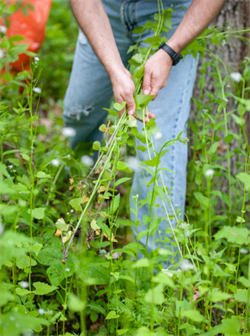 Garlic Mustard Weed Out Day is an annual tradition where volunteers hand-pull garlic mustard in natural areas all around Ann Arbor. Garlic mustard is an aggressive Eurasian species that can quickly crowd out native plant species and decrease natural diversity in the woods. Identifying and pulling garlic mustard is fun and easy for all ages, making this a great volunteer opportunity for families.
Garlic Mustard Weed Out Day is an annual tradition where volunteers hand-pull garlic mustard in natural areas all around Ann Arbor. Garlic mustard is an aggressive Eurasian species that can quickly crowd out native plant species and decrease natural diversity in the woods. Identifying and pulling garlic mustard is fun and easy for all ages, making this a great volunteer opportunity for families.
Participating Parks:
- Huron Hills Golf Course Woods– Meet us on Hunting Valley Road off Provincial Drive.
- White Oak– Meet at the park entrance on White Oak Drive.
- Huron Parkway– Meet at the Park Steward’s house: 3470 Woodland Road, off East Huron River Drive.
- Hannah– Meet at the west end of Bath Street, off 7th, just north of W. Huron Street.
- Black Pond Woods– Meet us on Tibbits Court, off Pontiac Trail.
- Argo– Meet in the parking lot north of the Argo Canoe Livery, off Longshore Drive.
